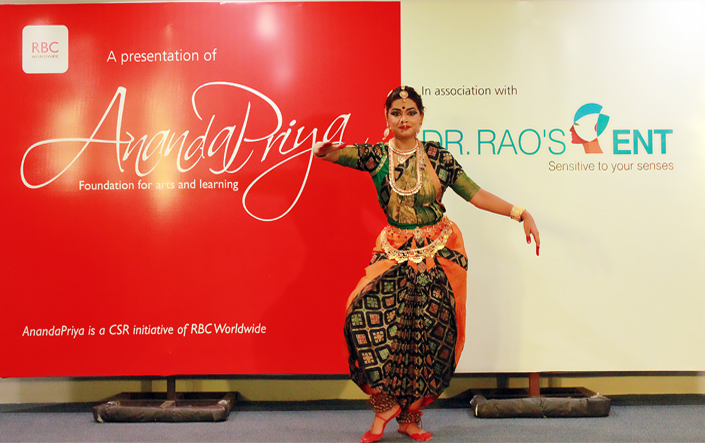AnandaPriya Foundation for Arts & Learning &
Dr. Rao's ENT Super Speciality International Hospital
presented an enthralling dance performance by Pujita Krishna Jyoti
About the Artiste – Pujita Krishna Jyoti
A dancer and writer, she has had a diverse career spanning several areas such as media, films, journalism, community work, teaching and training. With a Master’s degree in Fine Arts specializing in Dance from the University of California, Pujita has a multi-disciplinary background in dance. Her expertise is primarily in the Vilasini Natyam and Kuchipudi genres. She is a Doordarshan graded artist for Kuchipudi and has been noted for her achievements by various cultural forums and organizations. Her thesis ‘Revival of Vilasini Natyam at Ranganathaswamy Temple, Hyderabad’ has been published by Proquest, a prestigious academic publisher based in Michigan, USA. Pujita began her training in Vilasini Natyam in 2006 under the tutelage of Padmabhushan Swapnasundari and Dr. Anupama Kylash. She was awarded the best performance prize at the 112th annual festival of the prestigious Parthasarthy Sabha in Chennai in February 2013. She was also a recipient of the Ugadi Puraskar conferred by Dhanwantari Foundation, Hyderabad in 2014 and the IIDF award for Vilasini Natyam for 2016 by Samskruthi, an organization founded by Sri Shyamhari Chakra, a well-known dance connoisseur. About the Recital: The recital started with a traditional invocatory piece in Mohana Kalyani,‘Vighna Vinashakara’ which eulogises the big bellied god, Ganesha. The dancer described throgh well-crafted abhinaya, all his well-known traits and characteristics. The piece concluded with a typical set of movements that are unique to Vilasini Natyam known as the pandarayatu. Next up was a Pallavi in Ananda Bhairavi ragam. This pure dance item that is part of the alaya tradition or ritual component of Vilasini Natyam opened with a 300 year old churnika, which describes how an offering of flowers of different varieties is served before Lord Vishnu. This piece has been choreographed by Padmabhushan Swapnasundari. A Javali in Athana ragam, 'Aasa padaku pora' followed. Pujita evocatively brought out the rusticity of this kuttcheri aata, or courtly tradition of the kalavantulu. The item ended with a burst of pure dance known as the gaptu varasa, concluding once again with the pandarayatu. Pujita concluded her recital with Parijatam, typical of the aata bhagvatam tradition of dance. The piece was choreographed as a composite of various dramatic elements, with dialogues, dance and song all centred on the character of Satyabhama, the embodiment of love. A compilation of several librettos written by different authors, the item included interesting segments such as slokabhinaya, chandra dooshana and nakha shikha varnana.

